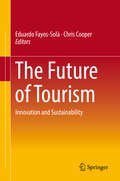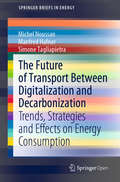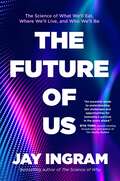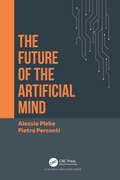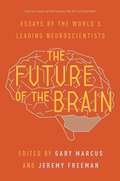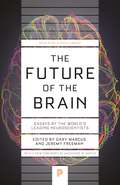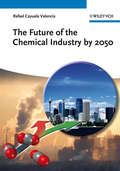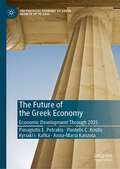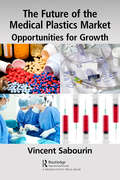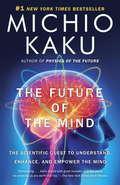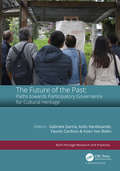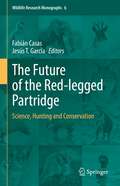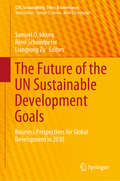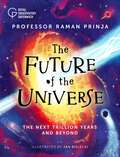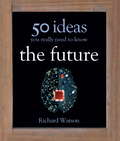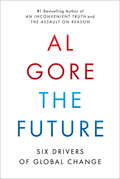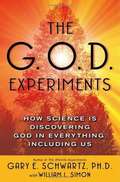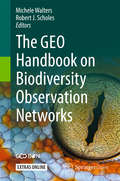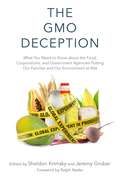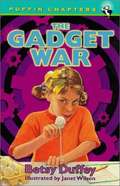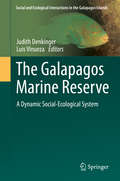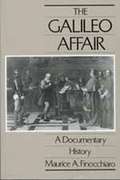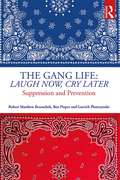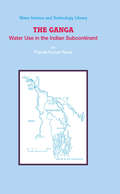- Table View
- List View
The Future of Tourism: Innovation And Sustainability
by Chris Cooper Eduardo Fayos-SolàThis book presents the foundations for the future of tourism in a structured and detailed format. The who-is-who of tourism intelligence has collaborated to present a definitive blueprint for tourism reflecting the role of science, market institutions, and governance in its innovation and sustainability. The book adopts a comprehensive approach, exploring recent research and the latest developments in practice to inform the reader about instruments and actions that can shape a successful future for tourism. Broad in scope, the book incorporates the perspectives of leading tourism academics, as well as the views of tourism entrepreneurs, destination managers, government officials, and civil leaders. The book is divided into three parts, the first of which addresses the scientific facets of innovation, analyzing the challenges and opportunities that technology provides for organic and disruptive developments in tourism, which will shape its future. In turn, the second part examines socio-cultural paradigms – with a view to dismantling traditional barriers to innovation. It also explores the role of heritage and the ethics of inclusiveness as drivers for sustainable tourism. The third part investigates new ways and means in governance and policy making for tourism. It introduces advances such as strategic positioning, symbiotic partnerships, and innovative management, and closes by presenting governance frameworks for an inclusive and sustainable future of tourism.
The Future of Transport Between Digitalization and Decarbonization: Trends, Strategies and Effects on Energy Consumption (SpringerBriefs in Energy)
by Simone Tagliapietra Manfred Hafner Michel NoussanEnergy systems are rapidly transitioning towards decarbonization, thanks in part to innovative digital technologies and changing mobility demands. This open access book examines the decarbonization and digitalization transformation in the transport sector, with a particular focus on energy consumption. By studying historical trends and outlining future scenarios, the authors illustrate the evolution of energy consumption in the transport sector, compare alternative decarbonization strategies, and analyze digitalization trends and their effects on energy consumption. The book addresses a broad readership of both academics and professionals working in the energy and transport industries, as well as readers interested in the ongoing debate over energy, mobility and climate change.
The Future of Us: The Science of What We'll Eat, Where We'll Live, and Who We'll Be
by Jay IngramA fascinating look at the cutting-edge science and technologies that are on the cusp of changing everything from where we&’ll live, how we&’ll look, and who we&’ll be, by the popular science broadcaster and bestselling author Jay Ingram.Where will we live? How will we get around? What will we look like? These are just some of the questions bestselling author and popular science broadcaster Jay Ingram answers in this exciting examination of the science and technologies that will affect every aspect of human life. In these pages, Ingram explores the future of our technological civilization. He reports on cutting-edge research in organ and limb regeneration, advances in prosthetics, the merging of the human and the synthetic, and gene editing. Vertical farming and lab-grown food might help feed millions and alleviate pressure on the planet. Cities could accommodate green space and the long-awaited flying car. Finally, he speculates on the future of artificial general intelligence, even artificial superintelligence, as well as our place on Earth and in the universe. The potential impact of these developments in science and technology will be powerful and wide-ranging, complicated by ethics and social equity. And they will inevitably revolutionize every aspect of life and even who we are. This is The Future of Us.
The Future of the Artificial Mind
by Pietro Perconti Alessio PlebeThe Future of the Artificial Mind is about the social and technological challenges posed by the new wave of artificial intelligence, both from a technical and a cognitive perspective. Deep neural networks have brought about tremendous technological improvements. This renaissance in artificial intelligence, after decades of stagnation, has enabled new technologies capable of surpassing human performance, as in the case of visual recognition. The book reviews the key ideas that have enabled these goals to be achieved and their historical origins. The book also considers some of the ethical and social challenges that the future development of artificial intelligence will face. Will humans fall in love with future android dolls? What will artificial sex be like? And what will it be like to travel in cars that will treat us as passengers instead of drivers? But predicting the future appears more magic than science. But when it comes to artificial intelligence, it is a constant temptation. Since it is well known that "the only way to get rid of a temptation is to enjoy it!", the hypothesis considered in the last chapter is that emerging trends point to a near future in which intelligence will be ubiquitous, but it will be difficult to identify its bearer. We may be heading towards an era of widespread intelligence, but an intelligence without accountability.
The Future of the Brain: Essays by the World's Leading Neuroscientists
by May-Britt Moser Edvard I. MoserThe world's top experts take readers to the very frontiers of brain scienceIncludes a chapter by 2014 Nobel laureates May-Britt Moser and Edvard MoserAn unprecedented look at the quest to unravel the mysteries of the human brain, The Future of the Brain takes readers to the absolute frontiers of science. Original essays by leading researchers such as Christof Koch, George Church, Olaf Sporns, and May-Britt and Edvard Moser describe the spectacular technological advances that will enable us to map the more than eighty-five billion neurons in the brain, as well as the challenges that lie ahead in understanding the anticipated deluge of data and the prospects for building working simulations of the human brain. A must-read for anyone trying to understand ambitious new research programs such as the Obama administration's BRAIN Initiative and the European Union's Human Brain Project, The Future of the Brain sheds light on the breathtaking implications of brain science for medicine, psychiatry, and even human consciousness itself.Contributors include: Misha Ahrens, Ned Block, Matteo Carandini, George Church, John Donoghue, Chris Eliasmith, Simon Fisher, Mike Hawrylycz, Sean Hill, Christof Koch, Leah Krubitzer, Michel Maharbiz, Kevin Mitchell, Edvard Moser, May-Britt Moser, David Poeppel, Krishna Shenoy, Olaf Sporns, Anthony Zador.
The Future of the Brain: Essays by the World's Leading Neuroscientists (Princeton Science Library #146)
by Gary Marcus and Jeremy FreemanThe world's top experts take readers to the very frontiers of brain scienceIncludes a chapter by 2014 Nobel laureates May-Britt Moser and Edvard MoserAn unprecedented look at the quest to unravel the mysteries of the human brain, The Future of the Brain takes readers to the absolute frontiers of science. Original essays by leading researchers such as Christof Koch, George Church, Olaf Sporns, and May-Britt and Edvard Moser describe the spectacular technological advances that will enable us to map the more than eighty-five billion neurons in the brain, as well as the challenges that lie ahead in understanding the anticipated deluge of data and the prospects for building working simulations of the human brain. A must-read for anyone trying to understand ambitious new research programs such as the Obama administration's BRAIN Initiative and the European Union's Human Brain Project, The Future of the Brain sheds light on the breathtaking implications of brain science for medicine, psychiatry, and even human consciousness itself.Contributors include: Misha Ahrens, Ned Block, Matteo Carandini, George Church, John Donoghue, Chris Eliasmith, Simon Fisher, Mike Hawrylycz, Sean Hill, Christof Koch, Leah Krubitzer, Michel Maharbiz, Kevin Mitchell, Edvard Moser, May-Britt Moser, David Poeppel, Krishna Shenoy, Olaf Sporns, Anthony Zador.
The Future of the Chemical Industry by 2050
by Rafael Cayuela ValenciaDiscussing the technological supremacy of the chemical industry, including pharmaceuticals, and how it will adopt a leading position to solve some of the largest global challenges humans have even seen, this book details how the industry will address climate change, aging populations, resource scarcity, globality, networks speed, pandemics, and massive growth and demand.Following a detailed introduction to some of the megatrends shaping our world over the forthcoming decades, the book goes on to provide several scenarios of how the world could look by 2050, including 'business as usual' and a 'sustainable' one. Chapter 3 gives a comprehensive overview of the current status, while providing a short historical review of the chemical industry, its origins, achievements and fundamentals. The following chapter reviews the potential impact of each of the selected megatrends on the industry, while Chapter 5 proposes how it could look by 2050. Several features of the chemical industry are presented and discussed, including the industrial relevance from an economical, technological and profitability point of view. The largest chemicals markets in absolute and per capita bases and the areas and countries with largest growth potential for chemicals, pharmaceuticals and feedstock. This chapter also reviews the impact of climate change on the chemical industry from a feedstocks and products point of view and, more specifically, the potential costs in reducing CO2 emissions. A final, concluding chapter summarizes the forthcoming megatrends and potential challenges, opportunities and the outlook for the industry as a whole.
The Future of the Greek Economy: Economic Development Through 2035 (The Political Economy of Greek Growth up to 2030)
by Panagiotis E. Petrakis Pantelis C. Kostis Kyriaki I. Kafka Anna-Maria KanzolaThis book introduces the Political Economy of Alternative Economic Futures for the Greek economy up to 2035. The analysis is not restricted to the presentation of a series of forecasts but aims to develop a comprehensive framework for Greece’s future. The analysis covers five realms regarding alternative economic futures, which outline the political economy of Greece: sustainable development; sustainable governance; inclusive growth; evolution of human behaviors; and dynamic growth. A growth, an unsustainable growth, a transformation, and a falldown scenario are generated based on the severity of key-uncertainty factors' effects.
The Future of the Medical Plastics Market: Opportunities for Growth
by Vincent SabourinPlastics have occupied an important place in the modern medical industry. It has substituted traditional devices and products made of metal, other materials, and ceramics. Over recent years, increased reliance on transparent plastic pharmaceutical and medical products has produced remarkable breakthroughs that improve medical attention delivery and allow it to be more comfortable for the masses to live better and longer lives. The purpose of this handbook is to provide a strategic perspective on the market to identify opportunities for growth and promising niches in the medical plastics market. It also helps in analyzing emerging trends in medical plastics to facilitate new product development. The medical plastics market is a new field with a broad scope and unending opportunities for manufacturers and suppliers and medical practitioners from healthcare. With a combination of the right material and technology, it has a lot to offer to the patients with affordable pricing. By keeping the worth of the medical plastics market in mind, we have set some objectives. This book identifies growth factors in the medical plastics market and analyzes critical factors of success to compete. The author presents background on the medical plastics market by its usage, products, processes, and innovation. He also reviews existing studies on the medical plastics market for topics like market size, market growth, segment growth, and geographic markets.
The Future of the Mind: The Scientific Quest to Understand, Enhance, and Empower the Mind
by Michio Kaku#1 NEW YORK TIMES BESTSELLER • The renowned theoretical physicist and national bestselling author of The God Equation tackles the most fascinating and complex object in the known universe: the human brain.&“Compelling…Kaku thinks with great breadth, and the vistas he presents us are worth the trip.&” —The New York Times Book ReviewThe Future of the Mind brings a topic that once belonged solely to the province of science fiction into a startling new reality. This scientific tour de force unveils the astonishing research being done in top laboratories around the world—all based on the latest advancements in neuroscience and physics—including recent experiments in telepathy, mind control, avatars, telekinesis, and recording memories and dreams. The Future of the Mind is an extraordinary, mind-boggling exploration of the frontiers of neuroscience. Dr. Kaku looks toward the day when we may achieve the ability to upload the human brain to a computer, neuron for neuron; project thoughts and emotions around the world on a brain-net; take a &“smart pill&” to enhance cognition; send our consciousness across the universe; and push the very limits of immortality.
The Future of the Past: Paths towards Participatory Governance for Cultural Heritage
by Gabriela GarcíaThe Future of the Past is a biennial conference generally carried out during the commemoration date of the incorporation of Santa Ana de Los Ríos de Cuenca Ecuador as a World Heritage Site (WHS). It initiated in 2014, organized by the City Preservation Management research project (CPM) of the University of Cuenca, to create a space for dialoguing among interested actors in the cultural heritage field. Since then, this space has served to exchange initiatives and to promote coordinated actions based on shared responsibility, in the local context. The third edition of this conference took place in the context of the 20th anniversary of being listed as WHS and a decade of CPM as the Southern host of the PRECOM³OS UNESCO Chair (Preventive Conservation, Maintenance and Monitoring of Monuments and Sites). For the very first time, and thanks to the collaboration with the Raymond Lemaire International Centre for Conservation of the University of Leuven (Belgium), the conference expanded its local scope. On this occasion, contributions reflected round a worldwide challenge in the cultural field: revealing the paths towards participatory governance of cultural heritage. Participatory governance is understood as institutional decision-making structures supported by shared responsibilities and rights among diverse actors.
The Future of the Red-legged Partridge: Science, Hunting and Conservation (Wildlife Research Monographs #6)
by Fabián Casas Jesús T. GarcíaThere has been a recent upsurge of red-legged partridge research in most countries where the species is distributed, but no comprehensive review of that fresh and relevant multidisciplinary and international knowledge is available. In fact, this is probably the first scientific book on this important species, apart from Dick Potts’ excellent works on British-introduced population, or ONCFS’s (Office Nationale de la Chasse et le Faune Sauvage, France) older technical reports. This is in strong contrast with a plethora of literature in hunting magazines or non-academic books, not often precise, realistic, or well informed. Thus, the book fills a great bibliography gap that could have important social impact. The common thread of the book is the prominent role a species like this may play for research, from basic physiological or ecological knowledge to socio-economics of hunting and the rural world. The general framework of the book [I1] is the important role that hunting and game management may play in both rural economies and biodiversity conservation, with the partridge as flag species, and also in identifying the “dark drift” that industrial, incorrectly deployed management, or hunting vision may have on both sustainability of resources and nature conservation at large. The final aim of the book is identifying the best future scenario, both for partridge hunters and managers as well as the general public.
The Future of the UN Sustainable Development Goals: Business Perspectives for Global Development in 2030 (CSR, Sustainability, Ethics & Governance)
by Samuel O. Idowu René Schmidpeter Liangrong ZuThis book provides a business-oriented analysis of the United Nations (UN) Sustainable Development Goals (SDG). In order to assess their impact on businesses and corporations, the book addresses all 17 goals and a broad range of industries. Gathering contributions from Africa, Europe and Asia, it presents both critical reviews and case studies. In turn, the book seeks to predict likely developments during the next decade. To do so, it examines evidence from today’s business world and how companies and corporations have been adopting the SDGs since their release. In this regard, it discusses the changes that will be required and how the agenda will affect the continent’s development path. An underlying theme throughout the book is the role of monetary value and investment for sustainable development: whether through financing, enhanced turnaround resulting from a more educated population, or more socially innovative entrepreneurs.
The Future of the Universe
by Raman PrinjaExperience the explosive and colourful future of the cosmos, zooming trillions of years ahead in time with Professor Raman Prinja, published in association with Royal Observatory Greenwich.The Future of the Universe starts the future clock NOW and rockets readers along a forward time line to discover what scientists predict will happen to the universe, including a shiny new ring on Mars, Earth's axis flip and a dramatic galaxy crash!This is the first book of its kind for this age - putting all the future events into one place along a clear timeline, from the return of famous comets in a few decades, to the dark end of the Universe a nonillion years from now.Professor Raman Prinja is the international, multi-award-winning Head of Department for Physics and Astronomy at University College London and a celebrated children's author of many books, including Planetarium and Wonders of the Night Sky. Illustrator Jan Bielecki's action-packed, vivid artwork plucks these astonishing phenomena out of the distant future, and explodes them on the page - sizzling red giant stars and deep, mysterious dark energy; doomed moons and trailing comets - they're all inside The Future of the Universe!Professor Prinja pens this unique look at the Universe's future as his follow-up to the definitive and exciting Wonders of the Night Sky, which introduces anyone with a patch of sky and a curious mind to exploring the marvels on display in today's Universe. The next generation of Universe explorers can easily engage with astronomy through these stunning books, no expensive equipment needed.
The Future: 50 Ideas You Really Need to Know
by Richard WatsonA dynamic insight into how science will shape human destiny over the coming century.What will the world look like in 2020, 2030 or even 2100? How will progress in scientific research affect human life in the areas of health and lifestyle, energy and the environment, politics and conflict, space exploration and even the ultimate questions of existence? This book offers an electrifying trip through the wonders - and terrors - awaiting us over the next hundred years.
The Future: 50 Ideas You Really Need to Know (50 Ideas You Really Need to Know series)
by Richard WatsonA dynamic insight into how science will shape human destiny over the coming century.What will the world look like in 2020, 2030 or even 2100? How will progress in scientific research affect human life in the areas of health and lifestyle, energy and the environment, politics and conflict, space exploration and even the ultimate questions of existence? This book offers an electrifying trip through the wonders - and terrors - awaiting us over the next hundred years.
The Future: Six Drivers of Global Change
by Al GoreFrom the former vice president and #1 New York Times bestselling author comes An Inconvenient Truth for everything--a frank and clear-eyed assessment of six critical drivers of global change in the decades to come. Ours is a time of revolutionary change that has no precedent in history. With the same passion he brought to the challenge of climate change, and with his decades of experience on the front lines of global policy, Al Gore surveys our planet's beclouded horizon and offers a sober, learned, and ultimately hopeful forecast in the visionary tradition of Alvin Toffler's Future Shock and John Naisbitt's Megatrends. In The Future, Gore identifies the emerging forces that are reshaping our world: * Ever-increasing economic globalization has led to the emergence of what he labels "Earth Inc."--an integrated holistic entity with a new and different relationship to capital, labor, consumer markets, and national governments than in the past. * The worldwide digital communications, Internet, and computer revolutions have led to the emergence of "the Global Mind," which links the thoughts and feelings of billions of people and connects intelligent machines, robots, ubiquitous sensors, and databases. * The balance of global political, economic, and military power is shifting more profoundly than at any time in the last five hundred years--from a U.S.-centered system to one with multiple emerging centers of power, from nation-states to private actors, and from political systems to markets. * A deeply flawed economic compass is leading us to unsustainable growth in consumption, pollution flows, and depletion of the planet's strategic resources of topsoil, freshwater, and living species. * Genomic, biotechnology, neuroscience, and life sciences revolutions are radically transforming the fields of medicine, agriculture, and molecular science--and are putting control of evolution in human hands. * There has been a radical disruption of the relationship between human beings and the earth's ecosystems, along with the beginning of a revolutionary transformation of energy systems, agriculture, transportation, and construction worldwide. From his earliest days in public life, Al Gore has been warning us of the promise and peril of emergent truths--no matter how "inconvenient" they may seem to be. As absorbing as it is visionary, The Future is a map of the world to come, from a man who has looked ahead before and been proven all too right.
The G.O.D. Experiments: How Science Is Discovering God in Everything, Including Us
by William L. Simon Gary E. SchwartzDOES GOD EXIST ONLY IN OUR HEARTS? According to highly esteemed scientist Gary E. Schwartz, Ph. D. , there is compelling scientific evidence that we no longer have to accept God on faith alone. Through a multidisciplinary approach, Harvard University-educated Dr. Schwartz blends psychology, quantum physics, and mathematics to examine the science of spirit. Faith and science are not mutually exclusive, and a better understanding of their relationship can lead us to recognize how God operates in everything. Trained in the scientific method as an "open-minded skeptic," Dr. Schwartz was taught how to raise questions, turn them into hypotheses, and design experiments to test them. He was not trained to consider the nature of God. And yet, his scientific research led him directly to the discovery of God's existence in intelligent evolution and everyday life. Scientifically rigorous and spiritually reassuring, this eye-opening book is a wake-up call for anyone who wonders about life's true meaning and who longs to believe in the existence of a universal intelligence.
The GEO Handbook on Biodiversity Observation Networks
by Michele Walters Robert J. ScholesBiodiversity observationsystems are almost everywhere inadequate to meet local, national andinternational (treaty) obligations. As a result of alarmingly rapid declines inbiodiversity in the modern era, there is a strong, worldwide desire to upgradeour monitoring systems, but little clarity on what is actually needed and howit can be assembled from the elements which are already present. This bookintends to provide practical guidance to broadly-defined biodiversityobservation networks at all scales, but predominantly the national scale andhigher. This is a practical how-to book with substantial policy relevance. Itwill mostly be used by technical specialists with a responsibility forbiodiversity monitoring to establish and refine their systems. It is written ata technical level, but one that is not discipline-bound: it should beintelligible to anyone in the broad field with a tertiary education.
The GMO Deception: What You Need to Know about the Food, Corporations, and Government Agencies Putting Our Families and Our Environment at Risk
by Ralph Nader Sheldon Krimsky Jeremy GruberSeventy-five percent of processed foods on supermarket shelves-from soda to soup, crackers to condiments-contain genetically engineered ingredients. The long-term effects of these foods on human health and ecology are still unknown, and public concern has been steadily intensifying.This new book from the Council for Responsible Genetics gathers the best, most thought-provoking essays by the leading scientists, science writers, and public health advocates. Collectively, they address such questions as:Are GM foods safe and healthy for us?Will GM food really solve world hunger?Who really controls the power structure of food production?Are GM foods ecologically safe and sustainable?Why is it so difficult to get GM foods labeled in the US?What kinds of regulations and policies should be instituted?How is seed biodiversity, of lack thereof, affecting developing countries?Should animals be genetically modified for food?How are other countries handling GM crops?Ultimately, this definitive book encourages us to think about the social, environmental, and moral ramifications of where this particular branch of biotechnology is taking us, and what we should do about it.
The Gadget War
by Betsy DuffeyMEET THE GADGET WHIZ.. Kelly Sparks has forty-three inventions to her credit -- and she's only in third grade! Just name a problem, and in no time Kelly will come up with a gadget to solve it. But when Albert Einstein Jones walks into Kelly's class, he becomes Kelly's stickiest problem yet! Albert's been to Young Inventor's Camp, and he's determined to prove who the real gadget whiz is. This is sure to be a mastermind fight to the finish!
The Galapagos Marine Reserve
by Judith Denkinger Luis VinuezaThis book focuses on how marine systems respond to natural and anthropogenic perturbations (ENSO, overfishing, pollution, tourism, invasive species, climate-change). Authors explain in their chapters how this information can guide management and conservation actions to help orient and better manage, restore and sustain the ecosystems services and goods that are derived from the ocean, while considering the complex issues that affect the delicate nature of the Islands. This book will contribute to a new understanding of the Galapagos Islands and marine ecosystems.
The Galileo Affair: A Documentary History
by Maurice A. FinocchiaroThis book provides a documentary history of the series of developments which began in 1613 and culminated in 1633 with the trial and condemnation of Galileo.
The Gang Life: Suppression and Prevention
by Robert Matthew Brzenchek Ben Pieper Garrick PlonczynskiThe Gang Life: Laugh Now, Cry Later examines the criminal gangster mindset and offers gang prevention strategies, using real-world examples to demonstrate a holistic approach toward combatting this surging societal problem. The text outlines the evolution of gang membership from a state of interest, to association, to hardcore "O.G." (Original Gangster) status, and explores the evolution of law enforcement’s multi-pronged approach to combating criminal street gang violence, from the catch-and-release mentality of the 1970s and 1980s to today’s collaboration with private organizations such as Boys & Girls Clubs. In-depth profiles, case studies, and lengthy histories of gangs, gang members, and their transformations are provided to demonstrate the deleterious effect of gangs on society. Designed for criminal justice students and for practitioners in the field, this text offers readers a holistic approach toward gang prevention from three nationally awarded educators and gang investigators.
The Ganga
by Pranab Kumar ParuaThe geo-hydro-morphometry of the river Ganges has a history of long and wide variations as the river is continuously fed by the high Himalayas hill ranges, the highest in the world. The river is categorized as an international one, passing through several independent countries. The major flow of the river used to flow through the branch river, Bhagirathi-Hooghly on the banks of which both city and port of Calcutta (now renamed Kolkata) are situated. However, due to massive tectonic and morphological changes, the flow through the branch river has gradually decreased resulting in enormous damages to the port and the city. After more than a century of investigations on the probable causes of deterioration and its remedies, a barrage across the river had been constructed near a place called Farakka in the Murshidabad district of West Bengal, India for diversion of a part of lean season flow (40,000 cu secs) from the parent river to the branch river for the resuscitation of the branch river and revitalization of the port of Calcutta. The turmoil started since the construction of barrage between 1965-1975 and the major neighbouring countries, India and Bangladesh, were locked in the dispute over sharing the water of the parent river. After several rounds of discussions at different levels between the two countries, short-term agreements were signed two times, one in 1977 and the other in 1985, and finally one long term Treaty was signed in 1996 between the two countries in an atmosphere of peaceful co-existence. Audience: The book will be of interest to researchers and scientists, professionals and policymakers in water resources management and environmental science, conservation policy and development research.
